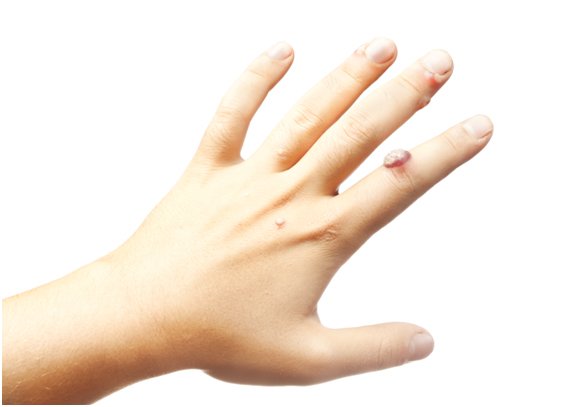Six months ago, I noticed I had a small round, raised spot on the pad of my right index finger. It was hard, flat, and instead of flesh-colored, it was a light gray. It wasn’t a blister, it didn’t itch or burn, but it was like a very small callus.
A month later, it was STILL there.
Two months later, it was STILL there. It stayed just like it was before: a small, round, raised, flat, light gray spot on the pad of my finger.
Hmm. Could it be a wart? When I showed it to my doctor the following week at a checkup, he confirmed my suspicion. That spot on my finger was a wart.
I’m not alone. After acne, warts are the most common and annoying skin condition that people want to get rid of.
Warts are a viral infection of the outer layer of your skin called your epidermis. They are caused by the human papillomavirus, or HPV. The infected skin grows into a thickened mass that juts out from the healthy skin surrounding it. Warts are more often found on your hands and feet, and children are more likely to be affected than adults.
There are several main types of warts found in humans, including common warts, flat warts, and genital warts. Palmar warts appear on the palm of your hand, and plantar warts on the sole of your foot.
Most warts are relatively flat, but some grow outward with a “bushy” cauliflower-like appearance. They can also be different colors, like light gray, yellow, brown, even gray-black.
Although annoying and unsightly, most warts are harmless unless they appear in a conspicuous place like your face, or grow on a weight-bearing surface, like the bottom of your foot. If a wart creates pressure or pain when you walk on it, it should be removed.
How do you remove a wart? Most wart removal treatments work by damaging or destroying the infected skin. This triggers your immune system to react, attacking the virus in the afflicted area, helping to eliminate it.
If you leave them alone, nearly half of all warts will eventually go away by themselves. This can take up to 2 years for children and 2-5 years for adults.
Outside of a doctor’s office, most wart treatments involve applying a topical product to the wart for several weeks to about 3 months. For many people, this will work well, but some warts may refuse to go away.
Going to the doctor gives you the option of freezing the wart or applying a chemical more concentrated than those available without a prescription. These options are more expensive and can leave scars.
One common approach is to chemically “peel” the skin over time with a liquid or gel containing salicylic acid or other caustic chemicals. There are also wart removal products that cause a freezing effect. Most Compound W® wart removal formulations contain salicylic acid as either a concentrated liquid or a patch.
Here are 7 Tips to Help Treat Warts Effectively:
- Remove the Top Layer First
To enhance the penetration of your remedy into the wart, ALWAYS soak it in warm water for at least 5-10 minutes. Then, remove the upper layers of the wart with sandpaper or an emery board.
- Never Reuse Emery Board or Sandpaper
DON’T reuse the sandpaper or emery board used on your wart because it is now contaminated with the HPV virus that you just scraped off, and could re-infect. I prefer to use sandpaper instead of an emery board because I discard it afterward.
- Protect the Skin Around Your Wart
Apply the medication ONLY to the wart itself. Avoid using abrasives like sandpaper or emery boards on the normal skin around your wart. Injuring nearby healthy skin makes it easier for a wart to spread.
- Give it time
It takes weeks to respond to wart removal treatments and up to 3 months for warts to completely go away, and no treatment works on everyone. If you don’t notice improvement after 2 months, try something else.
- Try Salicylic Acid First
Concentrated salicylic acid has the best overall track record for removing warts. I suggest using highly concentrated salicylic acid gel, then covering it with a bandage or even duct tape.
- Combine Your Approach
For stubborn warts, using both freezing and a topical agent will give better results than applying them separately.


